5.2 The solution
|
| < Day Day Up > |
|
5.2 The solution
Catering to business needs, the Galaxia solution was formulated using the following methodology:
-
The Galaxia team looked at a generic set of requirements and identified the generic use cases that addressed these.
-
It tried to match these generic use cases to those of a standard pattern (in this case, the Portal composite pattern), hoping that simply customizing this pattern would cover the remaining use cases.
-
It then built a Solution Overview Diagram based on these generic use cases to help identify the business and application integration patterns. This gave a good starting point for identifying those applications that could satisfy the remaining requirements or estimate the development effort required to cover those requirements.
-
This analysis resulted in a "drill down" for identifying the runtime patterns, and finally the product mapping to cover the functional and non-functional requirements.
5.2.1 Requirement summary
Key requirements included:
-
A Web-based solution supporting the extended enterprise and minimizing deployment efforts
-
Harnessing the existing infrastructure and applications
-
Fine-grained access control to enterprise applications
-
Unified security and single sign-on
-
BPM [12] through a process/work-centric EAI in order to enable integration and process mapping
-
Process visibility and process management tools (monitoring)
-
A unified workplace and personalization
-
Web access to engineering data such as part drawings, product structure, product metadata, and other design-related content
-
Sharing design information through workflow
-
Paperless communication
-
Collaborative tools
-
Role-based authorization to view applications and data
-
Support for open standards and industry-proven technology
-
Specified reports and audits
-
An aggregated view of information
The generic requirements spelled out the need for a Dynamic Workplace providing the extended engineering community with the ability to work together in a business process by providing a secure and standard framework, and where the solution should scale to support existing/new business processes and multiple business processes.
5.2.2 Generic use cases for the solution
Based on these requirements, the team now had the set of generic use cases listed in Table 5-1 on page 214. [13]
|
5.2.3 Solution Overview Diagram and identification of patterns
The Solution Overview Diagram shown in Figure 5-4 focuses on the ECR process.
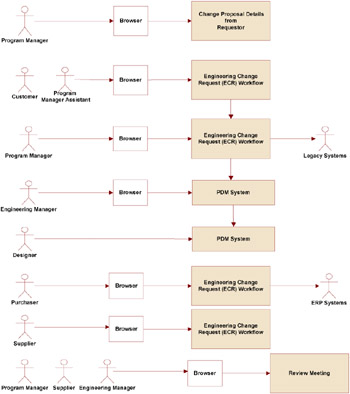
Figure 5-4: Solution Overview Diagram
The Solution Overview Diagram with the functional blocks and patterns shown in Figure 5-5 tells us we need an environment that will enable existing applications with new functional needs like collaboration, aggregation, and holistic views of information from different applications, direct access to native applications, etc.

Figure 5-5: Apply business and integration patterns to the Solution Overview Diagram
The Non-Functional Requirements for this solution include "ilities" like scalability, availability, maintainability, and manageability. The other NFRs include security features like authentication and authorization, personalized view of content, and managing content.
Figure 5-5 on page 217 brings clarity in terms of justifying the need for a portal solution
Why a portal solution?
Rationale: When the team made a comparison of the required solution's generic use cases with that of an existing asset like Portal, they saw that some of the Non Functional Requirements like security (authentication and authorization) are covered by the portal. The ease with which users and content can be managed is another positive argument for a Portal-based solution. These features are supported "out of the box" by a portal solution, thereby reducing development effort required to provide these essential functionalities. Many clients have complementary reusable assets (example—collaboration tools) that can easily be integrated with the portal. The Solution Overview Diagram shows the various actors performing assorted business functions using a Web interface. It would be beneficial if these interfaces/applications could be collated/aggregated to provide a toolset for performing the user's tasks.
The portal is standards-based and can scale well to include future requirements.
The Solution Overview Diagram shows that the business patterns do not occur independently. Application integrations are required to satisfy other functional requirements such as triggering workflows in other applications based on business rules/policies, view of data, and use of data from other applications/ data sources for effective decision-making.
5.2.4 Identification of Application patterns
The team next tried to identify application patterns which would be a good fit to cover these delta use cases. ePCM uses a process-focused Application Integration application pattern called Managed Process. This process-centric Integration pattern is required when Business Process Management is needed to drive an extended business process. This design is used for long-running business processes that often involve complex high-latency applications where the process can extend anywhere from minutes to days in duration.
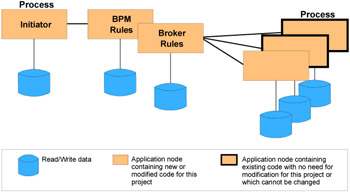
Figure 5-6: Managed Process pattern
Business Process Management extends the brokered approach to application integration with extended workflow-and process-state persistence services. Sophisticated recovery and exception handling can be implemented in the BPM rules system using process modeling tools. BPM provides an easily defined layer on top of existing processes to coordinate the execution of each individual operation. BPM coupled with the integration broker enables the long-running process to initiate each step through the integration broker to take advantage of its routing and transformation capabilities.
The integration broker along with the BPM rules (process templates) federate other enterprise applications like ERP systems, PDM systems, or legacy applications. This pattern allows triggering of existing application workflows, with end-to-end process integration.
-
The PCM [14] process requires users to access multiple applications and information sources to finish a unit of work.
-
Supplier and partner applications should be integrated in the change management process to synchronize design/production schedules and shorten product development cycle time. Here the extent of collaboration between business processes depends on the relationship between the businesses.
-
Individual applications have workflows that must be orchestrated rather than data consolidation.
-
PCM process latency is quite high and can last anywhere from minutes to days.
-
The application portfolio involved in the PCM process is diverse. It includes a mixture of pre-packaged software and homegrown custom applications.
Hence the Managed Process application pattern is a good fit to integrate complex business processes and applications.
Key benefits
-
Re-use of investment in existing enterprise applications/assets
-
End-to-end process visibility
-
Use of ePCM functionality, leading to better control over business processes
-
Quick implementation and faster ROI
Customized presentation to host [15]
Here the pattern discussion becomes specific to the application in terms of visualizing and accessing data normally reserved to a specific set of users. Engineering data and metadata about drawings, etc., are stored in PDM systems. This data must be shared and accessed by both engineering and non-engineering users to enable better decision-making in the business process flow. The key driver here is to expose an existing application to a wider audience. Products such as ENOVIA 3d com Navigator can be used to enable Web access for such data, thereby making use of existing assets. ENOVIA 3d com Navigator provides Web access to ENOVIA VPM (see "Sidebar: ENOVIA Products" on page 221) data that includes product structure, configuration, associated part drawings, and engineering metadata. This data can be both viewed and modified, provided the user has the required access rights.
For example, an ECR request correlates to the engineering data in a PDM/PLM system. This data can be the product structure, associated assembly/part drawings, documents, reports, etc. The drawings and documents related to an ECR can be viewed by managers and team leaders to review and help them make decisions, thereby reducing the latency of business events.
ENOVIA's e-business solutions for collaborative product data management and decision support are marketed, sold and supported by IBM and its business partners, and are a key component of the overall PLM set of solutions offered by Dassault Systèmes, a world leader in PLM with more than 65,000 customers in 80 countries.
ENOVIA 3d com Navigator
ENOVIA 3d com Navigator provides a single front-end to multiple information sources and applications for improving collaboration and decision-making. ENOVIA 3d com Navigator (N3G) accesses, visualizes, and publishes data stored in multiple ENOVIA PDM systems. ENOVIA 3d com Navigator (N3G) can be implemented as a set of modular components (portlets) that can be implemented within a WebSphere Portal environment, enabling organizations to build their own collaborative E2E or B2B business portals.
Because they leverage both Web and 3D technologies, ENOVIA 3d com Navigator products are the ideal solution for any company needing a single point of access uniting all extended enterprise information. This single point of access facilitates decision making, collaboration, and access to the product lifecycle pipeline.
V5 Virtual Product Modeling (VPM)
ENOVIA V5 VPM provides manufacturing companies with a state-of-the-art virtual product management solution. This allows them to deliver innovative products that can be easily modeled in many variants to meet market requirements without increasing manufacturing complexity in a shorter time to market.
Going beyond current digital mock-up technology that offers only 3D product visualization and navigation, ENOVIA V5 VPM captures and manages the engineering design intent by exposing specifications, engineering rules, operational parameters, simulation results, manufacturing process, and change context, which is key to understanding and evolving the product definition. This rich network of knowledge provides complete understanding of the relationship between a product's components, manufacturing, and maintenance technology. This allows engineers to perform necessary changes to the product design until its performance and cost are optimized. With relational design, change impacts can be easily analyzed and corrected, with change notifications automatically sent to impacted organizations.
Both ePCM and ENOVIA 3d com Navigator provide "out-of-the-box" functionality described by delta use cases. In order to expose these applications and capture the U2B [17] requirements, Galaxia used the Customized Presentation to Host self-service application pattern. Here applications are exposed as portlets to enable users to exploit their features and functionality through a portal. Providing access through a portal helps Galaxia take advantage of the portal's security features, single workplace for accessing information/content, and collaborative toolsets.
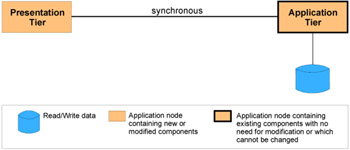
Figure 5-7: Customized Presentation to Host (U2B Topology 4)
For more details on this pattern, refer to IBM Patterns for e-business. [18]
Collaboration through Lotus Instant Messaging and Domino®
Lotus Domino and Instant Messaging [19] portlets can be used to resolve such needs as synchronous and asynchronous collaboration.
Especially in the Automotive and Aerospace industries, the change management process is a highly collaborative process involving different departments within the organization and its extended enterprise (e.g., suppliers and partners), where the organization and its suppliers commonly reside in different geographical locations.
Examples of "user-to-user" interaction include:
-
Engineering Change Requirements having to be defined through formal interactions between the design lead/manager, the initiator of the request, etc.
-
Suppliers and partners having to be notified that they must participate in team and review meetings regarding changes
-
Users needing access to multiple applications and information sources without every application requiring its own sign-on [20]
-
Customized access to contents required for various partners, suppliers, and internal users [21]
Galaxia needed to customize the Portal composite pattern to allow it to have this additional functionality. Hence the Portal composite pattern was customized to add delta application patterns.
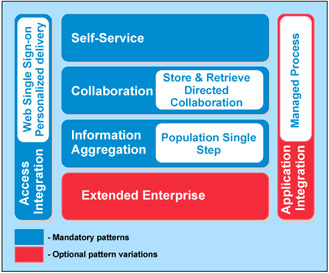
Figure 5-8: Dynamic Workplace—Portal composite pattern variant
5.2.5 Applying the delta Runtime patterns to the Portal composite runtime pattern
The Dynamic Workplace composite pattern is a custom Portal composite pattern that includes the mandatory and optional patterns. The delta Runtime patterns were added to the Portal composite pattern Runtime pattern to get the Dynamic Workplace composite pattern.
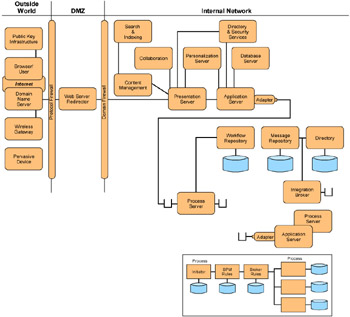
Figure 5-9: Galaxia solution—Runtime pattern
Business Process Management (BPM) can be achieved through process-or work-centric EAI. [22] Business processes can be visualized as activities that cut across many existing applications and tasks. These individual applications have pre-existing workflows that must be integrated in the overall business process. Many pre-packaged applications contain a workflow solution as part of their functionality. [23]
Therefore, an extended business process like ECR needs to link with the existing workflows as part of its processing. The Runtime pattern depicts the overall architecture based on the Application patterns.
The Runtime pattern is a variation of the standard Portal composite Runtime pattern that includes application integration requirements. It takes advantage of a portal implementation to leverage the concept of personalization, aggregation of disparate applications through a common window, providing access to content and applications based on roles and preference, and a collaborative framework that can be customized to suit business needs. The Runtime pattern includes an application integration framework that caters to such needs as federating workflows in individual applications and global process visibility through better business process management.
The Runtime pattern identifies the functional areas that will likely need to be addressed when considering this type of implementation. This pattern helped Galaxia identify products that could be used as well as how products in the target environment could be used to satisfy business needs.
5.2.6 Product mapping
To have a quick implementation of the suggested solution in the Runtime pattern, Galaxia needed to look at existing products containing the necessary features. Additional customization of such products and codification might be necessary at times to meet business requirements. Selection criteria for the best-fit product for each function can be based on:
-
Existing systems and platform investments
-
Available customer and developer skills
-
Customer choice
-
Future functional enhancement direction
-
Standards compliance
The products and technologies chosen should fit into the target environment and ensure quality of service (such as scalability and reliability) so that the solution can grow along with the e-business. The products identified for the Portal composite Runtime pattern variant are shown in Figure 5-10 on page 227.
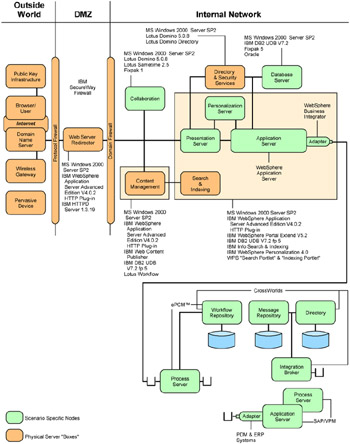
Figure 5-10: Galaxia product map
| Note | CrossWorlds® is now known as WebSphere Business Integration. |
After drilling down to the Runtime pattern we see the product map, which takes into account the existing applications and platform investments made by the industry.
Businesses have invested in PDM systems to create and store product information and in ERP systems to collect and store enterprise data. Some have made investments in stand-alone content management systems and collaborative tools such as Lotus products, which can be easily integrated and put to use effectively.
-
WebSphere Portal Server is an ideal candidate that fits the standard Portal composite pattern and adds "out-of-the-box" functionality, including:
-
User registration
-
User management
-
Authorization
-
Authentication
-
Single sign-on and security features, enabling standard access to enterprise applications and content
-
Personalization
-
Publishing and managing content
-
-
ePCM is standards-based and built on IBM's WebSphere Business Integration framework. The underlying products used are WebSphere MQ, WebSphere MQ Workflow, and DB2. It also takes advantage of its synergy with WebSphere Interchange Server EAI platform. ePCM acts as a workflow federator to manage various enterprise-wide processes, integrating enterprise-wide applications like ERP and engineering systems like PDM. Some of the key functionality supported by ePCM includes:
-
Enterprise workflow and process monitoring
-
Process orchestration and federation, which includes triggering application workflows and updating application data
-
Consolidated view of application data to enable better decision making
-
Object representation of process data and linking
-
Reports and auditing of processes
-
Document attachments and workflow
-
Workflow and e-mail notifications
-
-
Lotus Instant Messaging, Lotus Web Conferencing, and Lotus Domino are used to enable synchronous and asynchronous collaboration. These products add functionality such as e-meeting and e-mail integration.
Users can share application content using whiteboarding capability. The Instant Messaging chat feature enables synchronous collaboration. Review and team meetings can be conducted using this facility.
-
ENOVIA 3d com is a Web-based application used to access engineering data. [24] Some of the features in this application include:
-
Accessing engineering data such as parts and product structure stored in ENOVIA VPM
-
Building design context, viewing affected parts, and making design changes
-
Defining action flows and consolidating design changes
-
Visualizing DMU
Note Galaxia used ENOVIA 3d com Navigator to access engineering data. This application is specific to the ENOVIA VPM PDM system. You may have to use other Web-based applications to extract data from other PDM Systems.
-
5.2.7 On Demand Workplace
This product mapping leads to a solution that aims at being an On Demand Workplace.
The advantages of the Dynamic Workplace are:
-
Better-managed processes and efficient work management
-
A single place to do work, thereby improving the productivity of the workforce
-
Reduces process cycle time and latency of business events
-
Personalized content and inclusion of the extended enterprise
-
Paperless and effective communication
-
A decision support system with reports and audit trails
-
User- and role-based access control and authorization, reducing application development time and enabling content management
-
Scalable to include future business integration needs
-
Leverages existing skills
-
Standard "out-of-the-box" features, a portal infrastructure, and ePCM templates leading to quick deployment and faster ROI
-
A strong security framework for applications and data plus a library of available portlets, reducing application development cost
-
WebSphere Portal integrates well with Lotus applications and hence can provide collaborative capabilities with minimum customization effort
-
Quick ROI, aggregating access to existing applications and thereby enabling reuse of current investments
-
Ease of use and administration, leading to greater productivity
-
Lower TCO [25] (encompassing license, infrastructure, implementation, and maintenance costs)
The benefits highlighted for the Galaxia solution cover most of the reported IT priorities (see Figure 2-7 on page 51). This solution is a good framework to satisfy the requirements of an "on demand" workplace (see Figure 2-8 on page 60). It can be easily adapted to integrate new suppliers, customers, and IT infrastructure (e.g., PDM and ERP systems).
[12]Business Process Management
[13]Generic use case covered by the Portal composite pattern. Use cases covered by standard Portal composite pattern are shown in blue. Those shown in red are the delta use cases.
[14]Product Change Management
[15]Also known as U2B Topology 4
[16]http://plm.3ds.com/en/enovia/products/overview.asp
[17]User to Business
[18]http://www.ibm.com/developerworks/patterns/
[19]Formerly Sametime®
[20]Implementing single sign-on for applications running on different application servers requires complex modifications and migrations.
[21]The ability to control access to certain applications or information can be addressed by this pattern.
[22]Enterprise Application Integration
[23]For example, SAP R/3, PDM systems like ENOVIA VPM, or Lotus Notes®
[24]Refer to "Sidebar: ENOVIA Products" on page 221
[25]Total Cost of Ownership
|
| < Day Day Up > |
|
EAN: 2147483647
Pages: 82